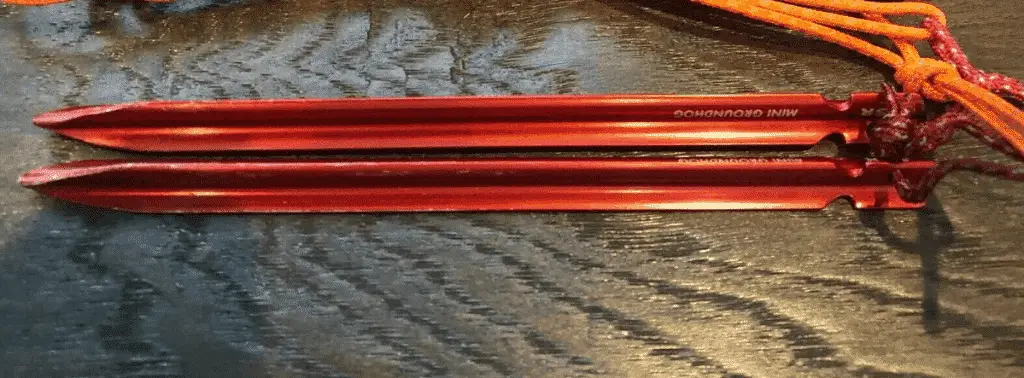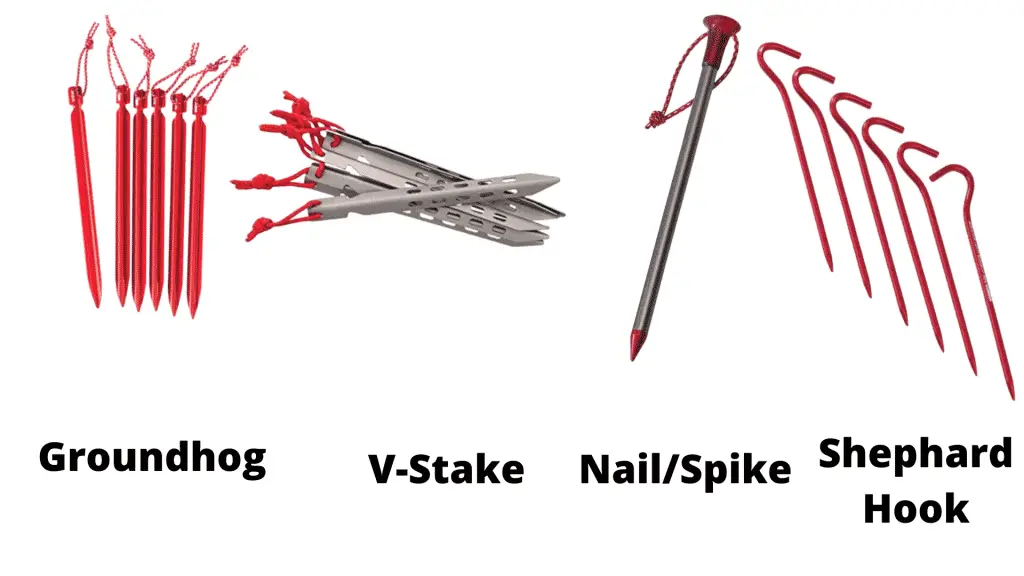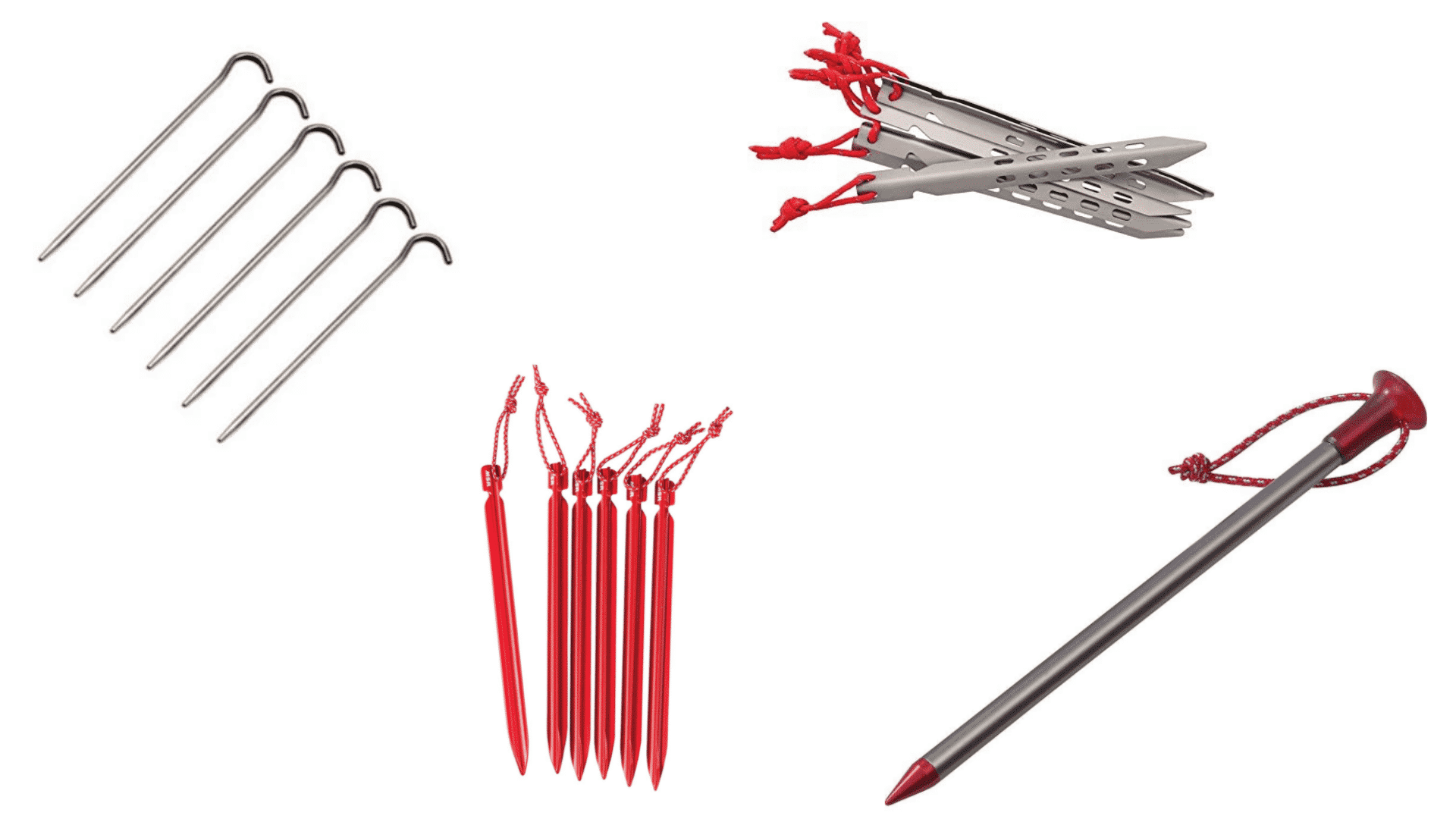Have you ever struggled to pound tent stakes into hard rocky ground? Sometimes you can’t avoid setting up camp in rocky, stony and firm soil. Tent stakes will bend and break if you’re not careful.
So what are the best tent stakes to use in hard rocky soil? You can’t just use any tent stake in rocky soil. I recommend using either the aluminum MSR Groundhog Stake or any heavy duty titanium model. Steel stake will also work, but they’re way too heavy for backpacking.
Personally, I would just go with the MSR Groundhog tent stake. It’s Y-Shaped aluminum body is lightweight and extremely durable. Plus it offers 60-70 lbs of holding power regardless of soil type. You won’t find a better all-purpose stake for the price.
With that being said, there’s no one size fits all solution for everybody. In the rest of this article I’ll walk you through choosing the different styles and stake materials.
Table Of Contents
The Best Tent Stakes For Rocky Ground
Sometimes you just can’t help but setup camp in hard rocky soil. Using the wrong stakes can’t get frustrating fast. You’ll have a hard time pounding them in and stakes will break.
Tent stakes just aren’t designed to be driving through rocks and rocks. It doesn’t matter what type of stake you choose, you won’t be able to pound through rock. You should aim for one simple goal. Don’t bend and damage your tent stakes!
When trying to pound stakes into rock soil, there are two main trains of thought. You can either use thin titanium hooks to pierce between the rocks or heavy duty MSR Groundhogs. Check out the following table where I compare the holding power of different stake styles.
| Tent Stake and Style | Tent Stake Length | Tent Stake Weight | Holding Power Range (lb) |
|---|---|---|---|
| MSR Groundhog Mini (Y-Beam) | 6″ | .35oz | 40-50lb |
| MSR Groundhog (Y-Beam) | 7.5″ | .43oz | 60-70lb |
| MSR Carbon Core Nail Stake | 6″ | .19oz | 32-40lb |
| Vargo Titanium V-Stake | 6.25″ | .38oz | 25*-55lb (Bad in Compacted Soil) |
| MSR Aluminum Shephard Hook | 6.75″ | .45oz | 25-35lb |
| Toaks Titanium Shephard Hook | 6.5″ | .23oz | 23-35lb |
| Vargo Titanium Shephard Hook | 6″ | .32oz | 20-30lb |
| Cheap Plastic Peg | 6″ | .40oz | 0-20lb (Couldn’t get it in Compacted Soil) |
Use a Y-Shaped Groundhog Peg in Rocky Soil

I would personally go with a MSR’s Groundhog Y-Shaped Stakes. There’s a reason why these are the most popular tent stakes on the planet. They can be used anywhere regardless of the soil type(V-Stakes better in sand).
The Groundhog has a Y-Shaped design which adds both strength and holding power. It’s by far the most durable aluminum stake on the market, so they won’t bend in rocky soil. Plus they only weigh .43oz each which is way lighter than the steel stakes that come with tents.
When made with quality materials the Y-shape is so strong that it can withstand repeated pounding. I’ve never found ground that’s so hard that I can’t setup a secure tent. The groundhogs will even smash through small rocks and roots.
Just don’t try to pound them through rocks/roots because it’s not going to happen. If you feel resistance pull up and adjust your angle. You should be able to work your way through.
You also need to consider the extra holding power of an MSR Groundhog. The full-length version has 60-70 lb of holding power in both loose and compact soil. That’s almost double the holding power of titanium shephard hooks. Less stakes in the soil means less risk of damaging your stakes.
These might not be the lightest pegs, but the versatility and strength makes up for the increase in weight. With such good reliability these stakes are well worth the added weight.
REI used to sell a knock off version of the MSR Groundhog, but it seems like they’re discontinued. You might want to try the Groundhog minis which are shorter and slightly cheaper.
Thin Titanium Shephard Hooks Can Fit Between Rocks

You can also go with heavy duty titanium shephard hooks, but these can be pricey. I have a bunch of generic titanium shephard hooks and they’re all basically the same. If you’re gonna buy titanium hooks look for the ones that have colored tops (Vargo Makes a Nice Set).
Titanium shephard hooks have 2 main advantages over the MSR Groundhog. They’re thin which allows them to slip between cracks and usually lighter. This also makes them slightly less durable, but they’re still better than aluminum.
For such a durable material titanium is kind of bendy. It’s almost like it bounces back after getting bent around rock. Don’t even bother with aluminum shephard hooks in rocky ground. You’re almost guaranteed to bend a stake, even if you’re being careful.
What About Steel Stakes?

Steel tent stakes are cheap and strong so they will definitely work in rocky soil. You might damage the steel striking into rock, but it will take a lot of damage. That doesn’t mean you should switch over to the cheap steel stakes that came with your tent.
Steel tent stakes have one major downside. They’re very heavy compared to titanium and aluminum. This isn’t a big deal for car campers, but it’s a lot of weight for backpackers.
The tent stakes that came with my tent weighed about 2 oz each. So a set of 6 tent stakes weighs close to 3/4 lb. My entire set of 6 MSR Groundhogs weighs less than a single steel shephard hook.
Sometimes You Can’t Use Stakes in Rocky Areas
Tent stakes aren’t designed to be driven through rock. You can usually find a place to push through with enough force, but sometimes it’s not happening.
Don’t worry! This doesn’t mean your tent will blow away. You’ll just have to find alternative ways to anchor down the tent. All you need is a little bit of weight to hold down the corners of your tent.
You might need to use heavy rocks to anchor down the corners of the tent. Just think about it for a second. A single 30lb rock in each corner of your should hold it down? That will give you the same holding power as shephard hooks in each corner (maybe more).
Further stabilize the tent by placing your pack and gear in the center. It’s not about completely avoiding movement. You’re just trying to avoid having your tent take off like a kite.
Driving Tent Stakes into Rocky Soil
You can usually just use your boots to drive tent stakes into rocky soil. They should go right in as long as you don’t hit root/rock. Unfortunately, most things in life don’t come easy.
Driving stakes into rock falls into its own category. You’ll need to use some type of hammer or rock to drive them into the ground. Just be careful so you don’t accidentally damage the stake. If the stake doesn’t move after a few whacks adjust the placement.
You can usually drive the stake in just by switching up the angle. Drop the angle down closer to the ground to go over and around the rock. This reduces the holding power, but can get you into the ground without damaging the stake.
Do I Need a Hammer?

Whether or not you need a hammer depends on your preferences. A cheap Coleman rubber mallet really isn’t all that heavy at 5.3oz. I occasionally leave my mallet at home to drop weight, but I just keep coming back to it. It’s nice and compact without weighing down my pack.
Ultralight campers will obviously want to shed the unnecessary weight. You can usually pound in a tent stake with a large rock. I have quite a few scars on my hands/wrist to prove how well that works. It might not happen at first, but you do eventually slip up and cut yourself on the stake.
There are nicer and more durable options out there, but boy are they heavy. Switching over to a steel/titanium hammer isn’t worth the added weight.
Other Things To Look For When Driving Into Rocky Soil
Why do some tent stakes work in rocky soil and others don’t? It all boils down to durability. Some stakes can’t handle the stress of driving into hard surfaces. Luckily tent stakes are cheap ($25 Max) so you shouldn’t have to compromise on quality.
Price: Aluminum vs Titanium
Aluminum stakes are by far the cheapest option, but that doesn’t mean they’re low quality. Obviously a $20 set of titanium shephard hooks will be stronger than a $5 aluminum set, but that’s not what I’m talking about.
Titanium shephards are similarly priced to aluminum Y-Beams like the MSR Groundhog. Would the groundhog be better if it was titanium? Yes it would, but it would be ridiculously expensive. It’s just not cost effective to make complicated designs like the Y-Beam out of titanium.
Titanium might be more durable than similarly designed aluminum stakes, but you can’t get the same holding power. A Y-Beam aluminum stake will offer more holding power and the same durability, but it’s twice the weight.
Only you can decide if you would rather have a premium design or better material. It doesn’t matter what you choose as long as the body is durable.
Material: Aluminum, Titanium, Steel
As a backpacker you will almost always want to go with either an aluminum or titanium stake. Steel is way to heavy to carry around in your pack.
Honestly, it’s hard to recommend titanium over aluminum. Titanium is lighter and stronger than aluminum, but that doesn’t make it better. It all boils down to stake design.
Titanium is expensive so the stake design suffers. So you basically have to choose between V-Stakes and Shephard Hooks. V-Stakes are basically only good in sand so that leaves you with titanium shephards hooks (30lb holding power).
Aluminum Y-Beam Stakes like the MSR Groundhog might be heavier, but they have twice the holding power(60-70 lb). I like to mix and match 2 groundhogs with 2-4 lightweight Vargo Titanium Shephard Hooks. You get to save a few grams of weight and have 2 heavy-duty anchor points on opposite corners.
Design/Style

With rocky soil you will want to go with either a Titanium shephard hook or Groundhog(Y-Style). Shephard hooks will be easier to drive in, but Groundhogs offer more hold and durability.
V-Stakes work well in soft ground like mud and sand, but they’re worthless in compact soil. Plus you have to deal with digging dirt out of all the grooves. You should really only use V-Stakes in loose sandy soil.
Nails/spikes are by far the lightest products on the market, but they usually have weak heads. You might be able to get away with using MSR Carbon Cores which are currently the lightest tent stakes on the market at .19oz. MSR Carbon Cores have reinforced heads so they rarely bend, but you need to be careful.
Length Matters: Short vs Long Stakes
Long stakes offer more holding power, but they’re hard to drive into rocky soil. What good is the extra length if you can only drive 4-5″ into the ground?
I personally think that the 6″-7.5″ range is the sweet spot. Shorter stakes don’t offer enough holding power and longer stakes are harder to drive all the way in the ground. Longer 9″-12″ shephard hooks have less durability, holding power and more weight than a Y-Beam.
You might want to check out my post that further compares tent stake length.
How Many Stakes Do I Need?
Most campers and backpackers will need to carry 4-6 tent stakes depending on the size of their tent. You will usually need to have 1 stake for every corner of the tent (2 in windy/snowy weather).
Large tents with extra sides will obviously need additional stakes. Check out my post that goes into further detail explaining how many stakes your tent needs.
Sometimes you might be able to get away without using any stakes. Are tents stakes really necessary? It depends on the weather and whether or not you’re willing to risk damaging your tent.



